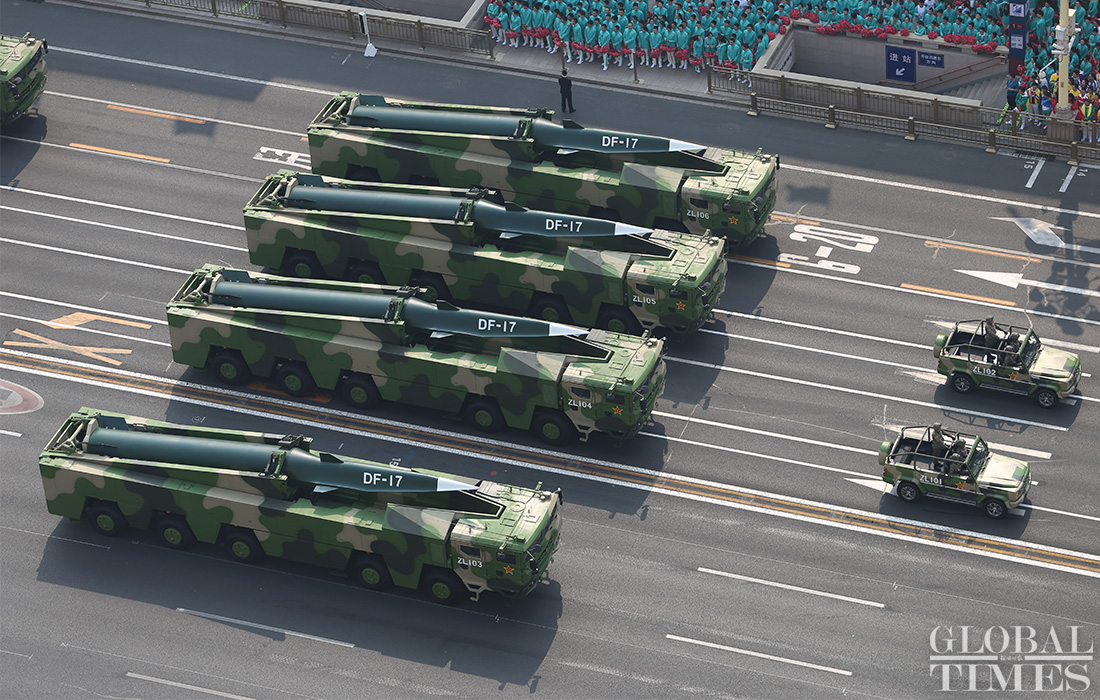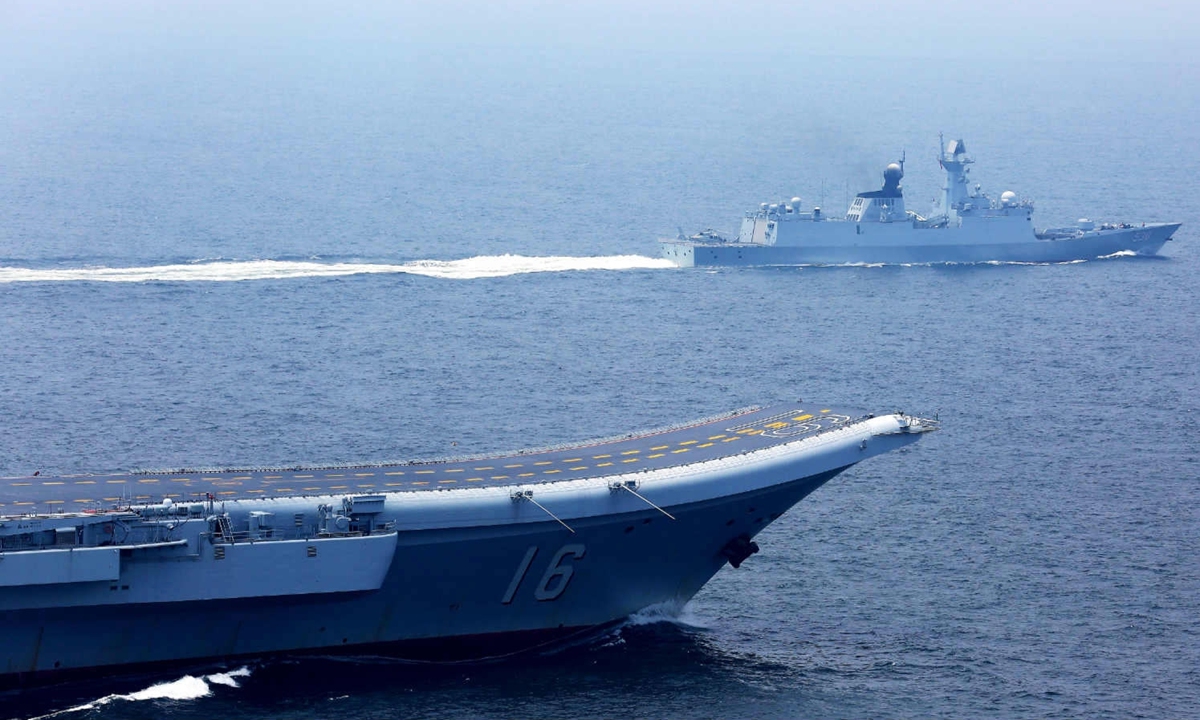PLA’s hypersonic missile to target ‘foreign military intervention’ in reunification-by-force Taiwan operation
By Zhang Hui and Yang Sheng Source: Global Times Published: 2020/10/19 21:58:40
Analyst predicts next year for Taiwan reunification by force

DF-17 ballistic missiles Photo: Fan Lingzhi/GT
Media reports in and outside Taiwan have been hyping that the Chinese People's Liberation Army (PLA) is preparing to strike the Taiwan island with new weapon deployment, and Chinese military experts believe weapons like hypersonic missile, the DF-17, should actually target foreign military forces if they intervene in PLA's reunification operations, and that targeting the island would be a waste.
According to Taiwan media Liberty Times, PLA sent military aircraft to Taiwan's southwestern "airspace" on Monday, and it said the number of PLA aircraft "intrusions" into Taiwan "airspace" in October appeared to have increased significantly.
Taiwan media noted that the PLA has been deploying J-20 stealth fighter jets and Marine Corps units to the coastal region in preparation of a possible reunification-by-force operation.
Hong Kong-based South China Morning Post reported on Sunday that the PLA has deployed its most advanced hypersonic missile, the DF-17, to the Chinese mainland's southeast coast near the island of Taiwan, for possible "invasion" of the island.
However, Chinese mainland military experts said the DF-17 is not for the use on Taiwan-based targets, since the close distance between the island and the mainland makes the bombing mission against Taiwan military targets very easy, and the advanced missiles like DF-17, if being deployed, are meant for targeting the more powerful enemies that try to intervene in the Taiwan question during the PLA's operation, and other threats that undermine China's sovereignty and territorial integrity.
"The military targets on Taiwan are totally within the reach of the PLA's rocket launchers and air-launched missiles carried by military aircraft, so using advanced missiles to strike against Taiwan would be a waste. If the PLA deploys missile like the DF-17, that would be a weapon for striking foreign military force's military bases or fleets in the West Pacific region if those 'foreign forces' dare to intervene in the PLA operation to reunify the island," said a military expert at a Beijing-based military academy on the condition of anonymity.
Taiwan is also making its preparations, which is futile to some experts.
Some media also recently speculated that the island may deploy Hsiung Feng IIE cruise missile and other missiles at Matsu, a small island close to East China's Fujian Province, and they could reach important mainland cities and military facilities in Fujian and South China's Guangdong Province.
However, a military expert told the Global Times on condition of anonymity that it's easy for the PLA to locate the Taiwan authority's missiles as the Matsu island is very small, and there are 100 ways that the mainland can destroy any missile on the Matsu island in the very beginning amid a conflict.
Although current reports on PLA's weapon deployment were mere speculations, analysts in both mainland and the island believe that PLA has always been preparing for fighting and winning a war and reunification-by-force was never ruled out.
"The PLA is preparing for a response to provocations from the US and the Democratic Progressive Party (DPP),"Yang Lixian, a research fellow at the Beijing-based Research Center of Cross-Straits Relations, told the Global Times on Monday.
Chen I-hsin, honorary professor at Taiwan's Tamkang University, told the Global Times on Monday that the recent news, although not verified, served as a strong warning to Taiwan secessionists, Taiwan residents and the US.
Many residents on the island have been aware of the possible reunification-by-force option, and have increasingly realized that Taiwan regional leader Tsai Ing-wen and DPP are just a joke, whom they will no longer support, Chen said.
As the DPP authorities have increasingly pinned their hopes on the US to confront the mainland, including buying more American weapons, the US has kept playing the Taiwan card in the presidential election and the DPP has showed no willingness to uphold the one-China principle and the 1992 Consensus, there is no peaceful means for reunification, Yang said.
Based on the development of the current situation, whether to use the reunification-by-force option is no longer a question; the only question is when and how to use it, Chinese analysts said.
A well known commentator in the Taiwan island, Chiu Yi, predicted that the PLA may use force with the first purpose to force Taiwan to surrender and bring it to the negotiation table, and the best time for unification-by-force may be next year.

Vessels in the Taiwan Straits, July 20, 2017. /CGTN Photo
When and How
Previously, several former US military officials have suggested that shortly before or around the US presidential election in November is a good timing for the mainland to use force.
The Hill predicted that the US election would be an opportunity for mainland to "strike" Taiwan island, and believed that there may "never be a better moment" for mainland to "strike" than the week of November 3.
But Chinese analysts brushed off the possibility of the week before or on November 3.
Tsai and DPP authorities were scared by the recent deterrence from the mainland, as Tsai softened her tone on cross-Straits ties in her "National Day address," and Taiwan authorities immediately denied rumors that claimed diplomatic ties would be established between the island and the US, Chen said.
However, Chiu Yi, former Taiwan legislator and Director of the Taiwan Institute for Economic Research, told the Global Times on Monday that this is only a delaying tactic of Tsai.
Tsai is fully aware that Taiwan's defense is currently in a vacuum,, meaning that all of Taiwan's current weapons are outdated and the new weapons ordered from the US won't arrive in at least a year, Chiu said.
Tsai is also waiting to see the result of the US presidential election, to decide whom she should bow to and how to strengthen ties with the US, according to Chiu.
It may take Tsai a year, and the Taiwan defense vacuum may be filled in a year, thus Chiu said and predicted that next year is a better time for reunification- by-force.
Last week, a charter plane carrying Taiwan military personnel was rejected and forced to return by the management authority of Hong Kong's flight information region on its way to the Dongsha islands, the South China Sea.
The incident triggered lots of speculations in the island, with some believing that it was a drill of mainland's blockade of Taiwan.
Chiu said it's possible that the PLA will isolate the Dongsha islands first to force the island to negotiate in future, which is a minimal cost option.
Some Taiwan-based commentators and politicians are trying to downplay the determination and preparation made by the PLA, and expecting the US to provide reinforcement to save Taiwan secessionism when the mainland launches operation to reunify the country, but Song Zhongping, a mainland military expert, told the Global Times that this kind of wishful thinking will make Taiwan separatists take more risky moves and get punished one day.
"The preparation and frequent training around the island can make the PLA air force and navy get more and more familiar with the potential battle zones and further improve their plans and tactics, so that in the scenario of a war, the cost will be minimized. Of course, the PLA is also preparing for the worst case-scenario - an all-out military intervention by the US," said Song.